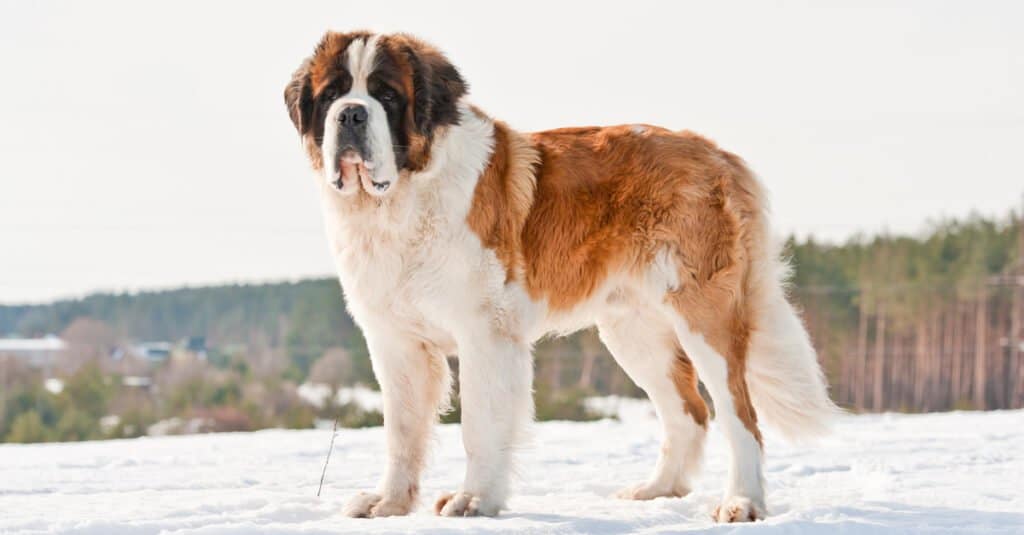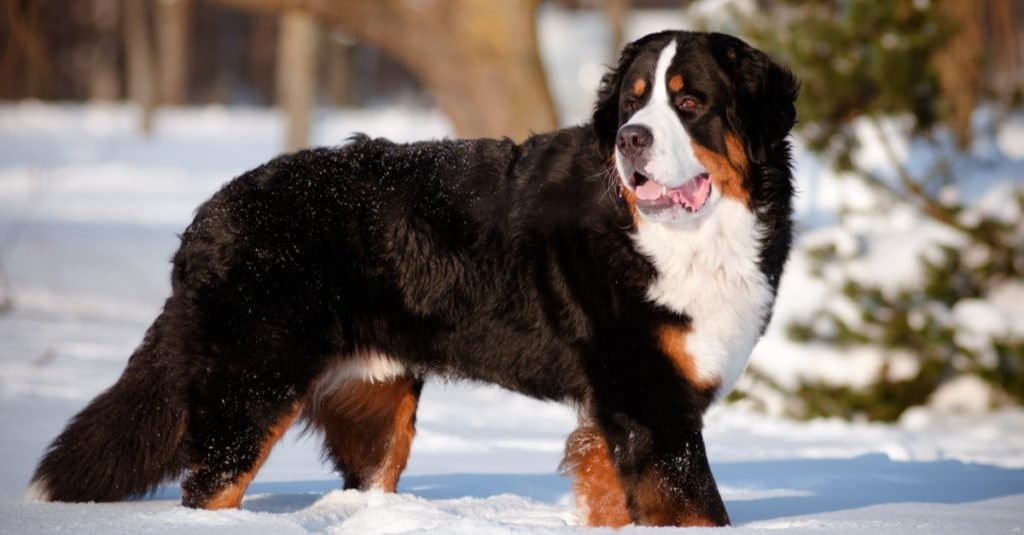Are you trying to choose your next doggie companion and curious about St. Bernard vs. Bernese Mountain dog? These two canines have a lot in common, yet they are also incredibly distinct. This post examines eight critical differences between the St. Bernard and the Bernese Mountain dog in terms of appearance, attributes, and health.
St. Bernard vs. Bernese Mountain Dog: A Comparison

| St. Bernard | Bernese Mountain Dog | |
|---|---|---|
| Height | 26 – 30 inches | 22 – 27 inches |
| Weight | 120 to 200 lbs. | 80 to 115 lbs. |
| Coat type | Rough, Dense, Smooth | Long, Thick, Dense |
| Colors | brindle, brown, mahogany, orange, red, rust, white | Black and White, Rust Markings |
| Temperament | Friendly, Independent, Social | Affectionate, Smart, Devoted |
| Trainability | Below Average | Above Average |
| Life Expectancy | 8 to 10 Years | 6 to 8 Years |
| Energy Levels | Below Average | Above Average |
Key Differences Between St. Bernard and Bernese Mountain Dog

The key differences between St. Bernard and Berner are size, energy level, and lifespan.
©Aneta Jungerova/Shutterstock.com
The key differences between Saint Bernard and the Bernese Mountain dog (a.k.a. Berner) are size, appearance, lifespan, origin, and temperament. Saint Bernards are frequently larger and heavier than Bernese Mountain dogs. Additionally, while Saint Bernard and Bernese Mountain dogs are related, their origin is distinct. For instance, Saint Bernard originated in the Western Alps of Italy and Switzerland, but the Berner originated in the Berne region of Switzerland.
Let us delve a little more into their distinctions.
Height
Both canines are quite tall; the Bernese Mountain dog is between 22 and 27 inches tall. Saint Bernard stands approximately 27 inches tall, with males standing 28-30 inches tall and females standing 26-30 inches tall.
Weight

Saint Bernard is heavier than the Bernese Mountain dog.
©Rita_Kochmarjova/Shutterstock.com
The Bernese Mountain dog is far lighter than St. Bernard despite its size. Bernese males weigh between 85 to 115 pounds, while females weigh 80 to 106 pounds. Saint Bernard males weigh between 140 and 200 pounds, while females weigh between 120 and 140 pounds.
Coat Type
Berner is the only mountain dog breed with a long, silky coat. Saint Bernard is available with either a shorthaired or a longhaired coat. The shorthaired coat is silky smooth but dense in appearance. The coat is slightly wavy but never frizzy or scruffy in the longhaired kind.
Color
The AKC accepts the following colors for St. Bernard: brindle, brown, mahogany, orange, red, and rust. All these colors are frequently mixed with white. All purebred Bernese Mountain dogs have a tricolor coat consisting of black, white, and rust, with rust-colored markings over the eyes, around the sides of the mouth, on the front legs, and out around the chest.
Temperament

Bernese Mountain dogs are loyal companions.
©otsphoto/Shutterstock.com
The first distinction is that, while both breeds make excellent family dogs, Saint Bernards are renowned for their fondness for children. They are particularly sensitive to their owners’ criticism, to the point of destruction in self-esteem. Therefore, they require a lot of love and praise. They also lack self-motivation and are typically sedentary. Although Saint Bernards are well-known for having a little lower cognitive level than other breeds, they are amazing family dogs when trained and socialized early.
Berners adore children as well, but not as much as Saint Bernards. Berners are similarly devoted to their humans and, as a result, are gaining popularity as therapy dogs. The Bernese Mountain canine is an intelligent dog that responds well to praise. Berners are livelier than Saint Bernards, and as such, they require a more active household. Not only do they require some additional exercise, but they must also be more vigorous.
Trainability
Both breeds are bright and willing to satisfy their owners when it comes to training. Both are receptive to training, which explains why they have historically performed well in human-related vocations. And with a treat in hand, you may be confident that positive reinforcement training will be the most effective method of training them.
However, it is critical to begin teaching your St. Bernard immediately, especially if it will spend most of its time indoors. While it is a puppy, professional training is best to ensure it properly understands social cues and commands. Bernese mountain dogs are easy to train and respond well to positive reinforcement and rewards.
Life Expectancy

Saint Bernard lives an average of eight to 10 years.
©Rita_Kochmarjova/Shutterstock.com
St. Bernard lives an average of eight to 10 years. When it comes to the Bernese Mountain dog, some sources state that they live between six to eight years, while others live between seven and 10 years. In either case, it is notably shorter than most other dogs.
Energy Level
Bernese mountain dogs have a higher activity level than other breeds of dogs, and as a result, they benefit from 20-30 minutes of daily exercise. They demand the freedom to roam, so an enclosed outdoor area is recommended, but they will prefer to be inside when you are home.
St Bernard is a laid-back dog with lower-than-average energy levels. They are adventurers at heart but are equally satisfied napping in the house. Saint Bernard is a good companion for families who are active or sedentary.
Are St. Bernards and Bernese Mountain Dogs both working dogs?
Traditionally, yes. The St. Bernard was bred for rescue work by the monks who operated a hospice for wayward travelers in the Great St. Bernard Pass in the Alps on the Italy-Switzerland border. The dogs would locate and carry travelers in distress to safety. They also developed a sense for when an avalanche was about to happen. It is estimated that St. Bernard dogs have saved 2,000 lives in three centuries of work for the hospice.
The Bernese Mountain dog has its roots in the Roman mastiff, known for his endurance as a laborer. The Berner was bred as a general farm dog that could drive cattle, protect the farm, and work as a draft animal pulling a heavy cheese cart. A strong working dog, indeed!
Wrapping Up
Both the Berner and Saint Bernard are huge and stunning breeds that attract attention. They are related, which accounts for their similarity, but small variances, such as their size and activity level, make them distinct from each other. Berners are more energetic than Saint Bernards and require a more energetic household. However, they both adore humans and other animals and enjoy being with the family!
The photo featured at the top of this post is © Jeff Bernhard, CC BY 2.0, via Wikimedia Commons – License / Original
Ready to discover the top 10 cutest dog breeds in the entire world?
How about the fastest dogs, the largest dogs and those that are -- quite frankly -- just the kindest dogs on the planet? Each day, AZ Animals sends out lists just like this to our thousands of email subscribers. And the best part? It's FREE. Join today by entering your email below.
Thank you for reading! Have some feedback for us? Contact the AZ Animals editorial team.






